A Series of Articles on Dental Care for Cats
Dental care for cats is a series of articles written for Siamese Cat Breeder by Sheila Calloway RVN.
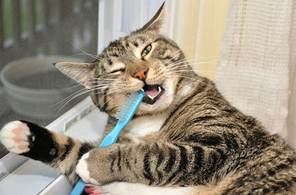
Sheila is a qualified veterinary nurse and has over 30 years experience either working with or keeping pets. She is especially passionate about showing and breeding her favorite felines – Siamese cats! Many thanks for the article Sheila.
Dental Care for Cats
These short articles aim to help readers understand common feline oral health problems and diseases, their symptoms and how and if they can be treated. Most importantly of all by having an understanding of dental care for cats you will know how cat dental problems can be prevented with the right approach to feline oral hygiene care.
Each article covers a specific area of oral health in cats including conditions, diet, practical considerations, some important things to note and useful as well as useless products (in my opinion!), all culminating together to provide a simple and easy to understand reference source of useful facts and information.
Oral hygiene related problems are one of the most common potential health troubles in cats and dogs over the average of 3 years.
Especially now that cats are living longer lives with better veterinary care, feline dental disease is a growing problem. Over 23% of cats have developed an oral problem between the ages of 3 – 4 years and the statistics increase as their age progresses.
With some breeds of cats, the risks are slightly higher, in particular Siamese and Abyssinian cats can unfortunately be more prone to oral problems.
However, I start with a health warning for you readers – some of the pictures might get a bit yukky as we progress through the series of articles, however I hope you find them helpful and worth looking at!
Read on…….
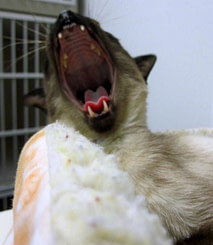
Cats Teeth
A mouthful of peggies and some are not even in the right place!
I guess we have all had to be polite and turn our faces discreetly in the opposite direction to gasp for fresh air when one of our cats has leapt onto our lap to enthusiastically meow incessantly into our face whilst nuzzling their cheeks with ours and purring with pleasure and greetings!
Eeeew what a pong, we think!
But it’s not their fault, we tell ourselves as we take a large gulp of sweet air and hold it, with lips pressed tightly shut and our nostrils pointing upwards as far as they will go before briefly and reluctantly returning the nuzzle to our affectionate companion!
Finally, as a last resort and before succumbing to a gypping fit or into semi unconsciousness, we pick up the offending source of the stink and firmly put it back down on the floor at an aroma-free distance. Preferably in another room!

Result: an indignant and most offended feline that saunters away to nurse her piqued, rather confused feelings of rejection. And quite right too – it certainly isn’t her fault.
In fact, it is probably our own fault, or at least there was perhaps more we could have done to help prevent it!
Cats were designed to hunt and catch small prey, which they devoured more or less whole. The abrasive action of hair and feathers and bones from prey animals probably helped to keep their teeth clean. Current soft diets may predispose cats to tartar and plaque formation, as well as the development of feline oral problems and diseases such as cavities (resorptive lesions).
Basic Oral Feline Anatomy & Facts
How the cat jaw has evolved:

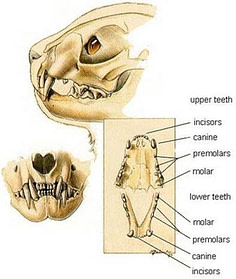
Kittens teeth begin to erupt at about two to four weeks of age. Kittens have 26 baby or milk (deciduous) teeth: 14 in the upper jaw and 12 in the lower jaw.
Permanent teeth emerge at about 3 to 4 months of age. Adult cats have 30 permanent teeth: 16 on the top and 14 on the bottom.
Retained Baby/Milk (Deciduous) Teeth or ‘Double Dentistry’
Special cells known as odontoclasts reabsorb the deciduous teeth, beginning from the root & working their way up to the crown. Once enough of the root has been reabsorbed, the baby tooth will usually become loose & fall out.
The process of deciduous reabsorbing in kittens can sometimes be seen as a slight reddening of the gums around the tooth line. This is normal and not something to be overly worried about.
Note: The gum should not look overly inflamed nor should the reddening persist for too long. If it does, this could be the onset of gingivitis (see later article). If you are concerned consult your vet.

A small amount of bleeding may also be evident where a baby tooth has fallen out, but this is not persistent or even noticed by some owners, nor is the lost tooth sometimes ever found…..!
Note: If bleeding appears heavier than you would expect or persists consult your vet.
When the baby teeth fail to fall out, you will see what appears to be a double set of teeth. The permanent teeth are then pushed out of line, leading to a bad bite (malocclusion).
The two sets of teeth are clearly visible and the condition of deciduous retention is present, which is sometimes referred to as ‘double dentistry’

Kittens from 2 to 3 months of age should therefore be watched carefully to see that their adult teeth are coming through normally and that their baby teeth fall out.
This picture shows an extra right third premolar tooth. This young cat was showing symptoms of “teeth grinding” which alerted its owners
The most common teeth to be retained are the upper canine teeth, followed by the lower canine teeth and the incisors.
Symptoms Caused by Retained Baby Teeth:
- Grinding teeth.
- Constant pawing at the mouth.
- Excess salivating.
- Refusal to eat.
- Bad breath.
- Abnormally positioned permanent teeth.
- Swollen, red, bleeding gums around baby teeth.
- Local gingivitis and periodontal disease.
Prevention of Retained Baby Teeth:
Feeding kittens on dry kibble, such as Royal Canin baby cat and/or kitten kibble, is much more effective at assisting this process than softer foods.
Kittens having to bite and crunch on hard kibble helps puts gentle pressure onto the weakened deciduous tooth to loosen and fall out.
Note: If you notice a baby tooth remains in place whilst an adult tooth is coming through, try wiggling the baby tooth gently to see if its loose enough to fall away, If not, the baby tooth will need to be removed.
DO NOT attempt pull the tooth yourself and DO NOT persist wiggling if your kitten clearly objects!
Consult your vet!
Incorrect Bite (Malocclusion)
Most bite problems in young cats are hereditary, resulting from genetic factors controlling the growth of the upper and lower jaws. However, some incorrect bites are caused by retention of baby teeth that push emerging adult teeth out of alignment (see above).
A cat’s bite is determined by how the upper and lower incisor teeth meet when the mouth is closed.
Normal teeth alignment (occulsion) for cats is called the scissors bite also known as interdigitation; the upper incisors just overlap but still touch the lower incisors.
An acceptable variation of this is the even or level bite, where the front incisor teeth meet edge to edge, however their canine and molar teeth of upper and lower jaws are still positioned in the scissors bite (interdigitation);
Examining a Cats Bite
To examine the cat’s bite, raise the upper lip while drawing down the lower lip. In a correct even or level bite, the front incisor teeth should meet edge to edge.

An overshot bite is one in which the upper jaw is longer than the lower jaw, so the teeth overlap without touching.

The undershot bite is the reverse, with the lower jaw projecting beyond the upper jaw.

Incorrect bites can interfere with the ability to grasp, hold, and chew food. Furthermore, teeth that do not align may injure the soft parts of the mouth.
However, incorrect bites that cause problems are much less common in cats than they are in dogs because cats’ heads are all quite similar in size and shape, despite differences in breeds.
However, short-nosed breeds, such as the Persian, are most susceptible to bite problems.
Note: In older cats, an incorrect bite may be the result of trauma, infection, or cancer of the mouth.
Symptoms of Incorrect Bite (Malocclusion)
- Teeth grinding.
- An “audible clicking” or “grinding sound”.
- Excessively salivating.
- Constant pawing at the mouth.
- Bad breath.
- Abnormally-positioned permanent teeth.
- Swollen, red, bleeding gums around baby teeth.
- Local gingivitis and periodontal disease due to teeth overcrowding.
- A permanent abnormal passageway between the mouth and nasal cavity (oronasal fistula).
Cat Oral Hygiene Care
This topic will be covered in more detail in a future article, in the meantime here are some general tips to help you get started so your kitten or cat can become accustomed to having its mouth examined:
Note: This will inevitably be much easier with some cats than others. Success can depend to some extent on your cats’ personality and their ability to trust and tolerate having their mouth examined. Oh and your patience!
Here are a couple of tips that just might help – good luck!
How to Examine Your Cat’s Mouth:
The sooner a young kitten experiences having its mouth examined the better and a very brief regular regime (no more frequent than once a day or alternate day) by the breeder or owner is a good starting point.
Start by gently holding the back of the kittens head to support it and then using the other hand.
Gently curl the lips at either side of the mouth to look at the teeth whilst reassuring the kitten.
Vary the side and angle of the examination each time as in the pictures below.
This is more easily done if your kitten is on your lap or being held by an assistant. If the kitten is free standing on the floor or surface, it will naturally try to back away from you and/or panic.
Tips for Examining a Kittens Mouth
- DO NOT try to force the mouth open!
- Keep the examination as brief as possible and do not persist, or enter into a struggle, or shout at your kitten to behave.
- If your kitten begins to object, stop immediately!
- Reassure your kitten with gentle praises and either cuddles or play afterwards as a reward and allow the kitten to go free if it wishes.
Hopefully the kitten will soon begin to trust you and the time and tolerance level will gradually increase – it is ultimately better to aim to be able to examine the mouth for a longer time less frequently.
So, once your kitten is not showing any signs of objection to you looking at her mouth for a little longer, reduce the frequency of the examinations to weekly.
Remember to try to be patient – if you are tense, your kitten will sense it and panic.
We will be looking at how to do more thorough and in-depth examinations of the mouth in a later article.
However in-between these elementary mouth examinations, here are a couple of tips which might just help prepare your kitten or cat for the next stage – oral hygiene & teeth cleaning!

Need I say anymore…..!
Coming soon on Siamese Cat Breeder my next article is about a cats broken teeth and dribbling!

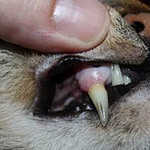
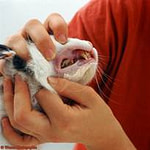

Excellent informative article! I look forward to reading your next ones.
Thank you Tina – I’m glad you liked the article.
I hoping to have the next one ready in a couple of weeks
Best wisehs
Sheila
Many thanks Sheila. Loved the article it was a great help!
Hi Sheila
I’m glad you liked the article and found it useful
I have written 3 more in the series and currently working on the final one.
I hope you enjoy them
Warmest regards
Sheila